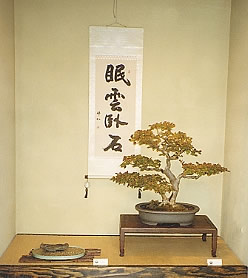Let’s start from the basic understanding of the words, “bonsai,” (Japanese) and “penjing” (Mandarin). “Bonsai” (盆栽) is a Japanese term meaning “tree in a pot “, and “penjing” (盆景) is a Chinese term meaning “landscape in a pot”. With the meanings of these two terms, we have a hint that the Chinese penjing is more of reproducing a miniature landscape than creating a perfect tree as Japanese are trying with their bonsai.
Chinese penjing artists try to recreate the beauty of nature without eliminating the imperfections of nature. There is a great deal of creative and natural freedom in how the artists may do this with penjing. The soul of penjing is revealed more in the whole presentation; the thematic message, the symbolism and poetry. The presentation is natural, without too much of the aesthetic depending on the anatomical details of the tree. Anatomical perfection is not a main requirement in penjing because nature is imperfect. Hence, the technical engineering skill important to bonsai is not so important in penjing. Instead, the application of skill should be relevant to the tree only in order to successfully convey the thematic message to viewers.
 |
 |
Left: A twin trunk Crape myrtle bonsai trained and later donated to the North American Bonsai Collection by Yuji Yoshimura. Right: A Maple forest penjing created by Wu Yee Sun.
Yet, I believe the difference between Chinese penjing and Japanese bonsai has become less distinctive, and will continue to be so. Since China’s Open Door Policy in the late 1970’s, Chinese penjing has gotten better known to the world. Today, bonsai artists from China, Japan and the West can easily share and exchange ideas, skills, and insight of bonsai with each other thru conventions, exhibitions, books, forums, etc.
